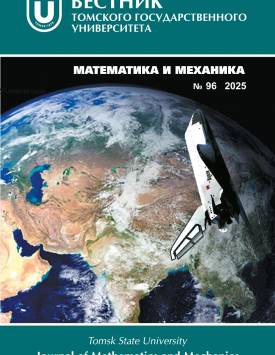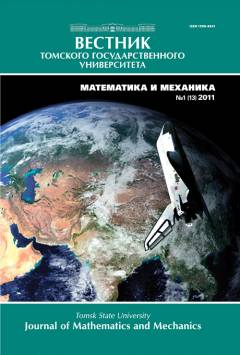Methodology of the numerical modeling of cutting for calculating the contact stress distribution: a case study on steel milling
This paper presents a general methodology for the numerical modeling of cutting using end milling as an example. The proposed multilevel model is specified with functional relations between the tool design parameters (shape of the end part, number of teeth, front and back angles), sharpness (radius of rounding) of the cutting edge, cutting modes (cutting speed, feed, cutting depth and width), physical and mechanical characteristics of the processed material, and the resulting equivalent Mises stresses in the cutting wedge of the milling tooth. The justification of the requirements for the finite element mesh is given. It is suggested to choose a rational option when splitting into elements. The assumptions of the model that allow reducing requirements to computing power without calculation quality losses, are justified.
Keywords
numerical modeling of cutting,
finite element method,
milling,
contact stressesAuthors
| Pivkin Pyotr M. | Moscow State University of Technology STANKIN | pmpivkin@gmail.com |
| Babaev Artyom S. | Tomsk State University | a.s.babaev@mail.tsu.ru |
| Kozlov Viktor N. | Tomsk State University | kozlov-viktor@bk.ru |
| Semyonov Artyom R. | Tomsk State University | artems2102@yandex.ru |
| Nazarenko Ekaterina S. | Moscow State University of Technology STANKIN | katarina.86@bk.ru |
| Nadykto Aleksey B. | Moscow State University of Technology STANKIN | abnadykto@yandex.ru |
Всего: 6
References
Denkena B., Kohler J., Sellmeier V., Morke T. Topography prediction of resilient parts after flank milling with chamfered tools // Production Engineering. Research and Development. 2011. V. 5. P. 273-281. doi: 10.1007/s11740-011-0305-2.
Denkena B., Bicke W., Sellmeier V. Flank milling of compliant workpieces with chamfered tools // Production Engineering. Research and Development. 2012. V. 6. P. 403-412. doi: 10.1007/s11740-012-0399-1.
Yen Y.-C., Jain A., Altan T. A finite element analysis of orthogonal machining using different tool edge geometries // Journal of Manufacturing and Materials Processing. 2004. V. 146. P. 72-81. doi: 10.1016/S0924-0136(03)00846-X.
Al-Athel K.S., Gadala M.S. The use of volume of solid (VOS) approach in simulating metal cutting with chamfered and blunt tools // International Journal of Mechanical Sciences. 2011. V. 53. P. 23-30. doi: 10.1016/j.ijmecsci.2010.10.003.
Yusoff A.R., Turner S., Taylor C.M., Sims N.D. The role of tool geometry in process damping milling // The International Journal of Advanced Manufacturing Technology. 2010. V. 50. P. 883-895. doi: 10.1007/s00170-010-2586-6.
Denkena B., Kohler J., Mengesha M.S. Influence of the cutting edge rounding on the chip formation process: Part 1. Investigation of material flow, process forces, and cutting temperature // Production Engineering. Research and Development. 2012. V. 6. P. 329-338. doi: 10.1007/s11740-012-0366-x.
Usui E., Shirakashi T. Mechanics of machining-from descriptive to predictive theory. In on the art of cutting metals - 75 years later // American Society of Mechanical Engineers. Publication PED. 1982. V. 7. P. 13-35.
Strenkowski J.S., Carroll J.T. A finite element model of orthogonal metal cutting // American Society of Mechanical Engineers. Journal of Engineering in Industrial Research. 1985. V. 107. P. 346-354.
Komvopoulos K., Erpenbeck S.A. Finite element modeling of orthogonal metal cutting // American Society of Mechanical Engineers. Journal of Engineering in Industrial Research. 1991. V. 113. P. 253-267.
Lin Z.C., Lin S.Y. A coupled finite element model of thermoelastic-plastic large deformation for orthogonal cutting // American Society of Mechanical Engineers. Journal of Engineering in Industrial Research. 1992. V. 114. P. 218-226.
Zhang B., Bagchi A. Finite element simulation of chip formation and comparison with machining experiment. // American Society of Mechanical Engineers. Journal of Engineering in Industrial Research. 1994. V. 116. P. 289-297.
Shih A.J. Finite element simulation of orthogonal metal cutting // American Society of Mechanical Engineers. Journal of Engineering in Industrial Research. 1995. V. 117. P. 84-93.
Strenkowski J.S., Carroll J.T. Finite element models of orthogonal cutting with application to single point diamond turning // International Journal of Mechanical Sciences. 1986. V. 30. P. 899-920.
Black J.T., Huang J.M. An evaluation of chip separation criteria for the FEM simulation of machining // The Journal of Manufacturing Science and Engineering. 1996. V. 118. P. 545-553.
Tugrul O., Erol Z. Finite element modeling the influence of edge roundness on the stress and temperature fields induced by high-speed machining // The International Journal of Advanced Manufacturing Technology. 2007. V. 35. P. 255-267. doi: 10.1007/s00170-006-0720-2.
Кожевников Д.В., Кирсанов С.В. Резание материалов. М.: Машиностроение, 2012.
Skripnyak V.V., Skripnyak V.A. Hexagonal Close-Packed (hcp) Alloys under Dynamic Impacts // Journal of Applied Physics. 2022. V. 28. P. 16-19. doi: 10.1063/5.0085338.
AUTODYN-TM Interactive non-linear dynamic analysis software theory manual. Horsam: Century Dynamics Inc., 1998.
Molinari A., Musquar C., Sutter G. Adiabatic shear banding in high speed machining of Ti-6Al-4V: experiments and modeling // International Journal of Plasticity. 2002. V. 18. P. 443-459. doi: 10.1016/S0749-6419(01)00003-1.
Zichuan Z., Lin H., Tao Zh. et al. Research on inverse identification of Johnson-Cook constitutive parameters for turning 304 stainless steel based on coupling simulation // Journal of Materials Research and Technology. 2023. V. 23. P. 2244-2262. doi: 10.1016/j.jmrt.2023.01.090.
Kozlov V., Babaev A., Schulz N. et al. Study of a Methodology for Calculating Contact Stresses during Blade Processing of Structural Steel // Metals. 2023. V. 13. doi: 10.3390/met13122009.
Бабаев А.С., Козлов В.Н., Семёнов А.Р., Шевчук А.С. и др. Исследование влияния параметров микрогеометрии режущих кромок на силу резания, износ и обрабатываемость при фрезеровании // Вестник машиностроения. 2024. Т. 103, № 10. С. 862-872. doi: 10.36652/0042-4633-2024-103-10-862-872.

